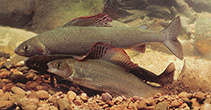Slovakia country information
Common names:
Lipen obycajný
Occurrence: native
Salinity: freshwater
Abundance: | Ref:
Importance: | Ref:
Aquaculture: | Ref:
Regulations: | Ref:
Uses: no uses
Comments: Also Ref. 683.
National Checklist:
Country Information: https://www.cia.gov/library/publications/resources/the-world-factbook/geos/lo.html
National Fisheries Authority:
Occurrences: Occurrences Point map
Main Ref: Holčik, J., 1996
National Database:
Occurrence: native
Salinity: freshwater
Abundance: | Ref:
Importance: | Ref:
Aquaculture: | Ref:
Regulations: | Ref:
Uses: no uses
Comments: Also Ref. 683.
National Checklist:
Country Information: https://www.cia.gov/library/publications/resources/the-world-factbook/geos/lo.html
National Fisheries Authority:
Occurrences: Occurrences Point map
Main Ref: Holčik, J., 1996
National Database:
Common names from other countries
分类 / Names 俗名 | 同种异名 | Catalog of Fishes(属, 种) | ITIS | CoL | WoRMS | Cloffa
Teleostei > Salmoniformes (Salmons) > Salmonidae (Salmonids) > Thymallinae
Etymology: Thymallus: Greek, thymallos, -ou = a kind of fish similar to salmon (Ref. 45335); thymallus: The name 'thymallus' could come from the thyme taste of the flesh of this fish (Ref. 30578).
More on author: Linnaeus.
Etymology: Thymallus: Greek, thymallos, -ou = a kind of fish similar to salmon (Ref. 45335); thymallus: The name 'thymallus' could come from the thyme taste of the flesh of this fish (Ref. 30578).
More on author: Linnaeus.
Environment: milieu / climate zone / depth range / distribution range 生态学
; 淡水; 半咸淡水 底中水层性; pH range: 7.0 - 7.5; dH range: 20 - ?; 非迁移的; 深度上下限 15 - ? m (Ref. 30578). 溫帶; 6°C - 18°C (Ref. 2059); 70°N - 42°N, 6°W - 66°E
分布 国家 | FAO区域 | 生态系 | 标本纪录 | Point map | 简介 | Faunafri
Europe: Barent Sea basin west of Urals, Caspian, Black, Baltic, White and North Sea basins, Atlantic westward to Loire drainage; Rhône drainage; northern Adriatic basin east to Soca drainage. Introduced over most of southern and central Finland.
歐洲: 在俄國西北部的英格蘭與法國到烏拉山。 伯恩公約的附錄 3(受保育的動物群).
歐洲: 在俄國西北部的英格蘭與法國到烏拉山。 伯恩公約的附錄 3(受保育的動物群).
Length at first maturity / 大小 / 重量 / 年龄
Maturity: Lm ? range ? - ? cm
Max length : 60.0 cm TL 雄鱼/尚未辨别雌雄; (Ref. 556); common length : 30.0 cm TL 雄鱼/尚未辨别雌雄; (Ref. 556); 最大体重: 6.7 kg (Ref. 6368); 最大年龄: 14 年 (Ref. 556)
Max length : 60.0 cm TL 雄鱼/尚未辨别雌雄; (Ref. 556); common length : 30.0 cm TL 雄鱼/尚未辨别雌雄; (Ref. 556); 最大体重: 6.7 kg (Ref. 6368); 最大年龄: 14 年 (Ref. 556)
简单描述 检索表 | 型态特徵 | 形态测量图
背棘 (总数) : 5 - 8; 背的软条 (总数) : 12 - 17; 臀棘: 3 - 4; 臀鳍软条: 9 - 10; 脊椎骨: 57 - 61. Distinguished from Thymallus arcticus by the following unique characters: maxillary usually reaching anterior margin of eye; pelvic fin grey, lacking red stripes; body without red spots; dorsal fin greyish, with parallel rows of round dark spots; gill rakers 19-30, averaging about 24-26 (Ref. 59043). Caudal fin with 19 to 21 rays (Ref. 2196).
尾鳍有 19 到 21个鳍条。 (参考文献 2196)
尾鳍有 19 到 21个鳍条。 (参考文献 2196)
Inhabits submontane reaches of rivers with a hard sand or stone bottom and well oxygenated, cold and fast-flowing water (Ref. 59043). Prefers running, well-oxygenated waters of rivers (Ref. 30578). In Scandinavia, it occurs in clear lakes and freshened part of northern Baltic basin. Usually lives in hollows behind boulders and shaded water under overhanging vegetation (Ref. 59043). Gregarious, forms schools (Ref. 2196). Feeds mainly on insects (Ref. 9696), nymphs, small worms and crustaceans (Ref. 30578). Breeds in shallow stretches, usually 20-40 cm deep, or riffles, with moderate current of about 0.5 m/s and clean gravel bottom (Ref. 59043). Can be captured with natural bait (insect larvae) or with artificial fly. Very sensitive to pollution (Ref. 30578).
群居的, 形成鱼群.(参考文献 2196) 偏爱河的流动且溶氧度高水域。 (参考文献 30578) 栖息于河的清澈上游,底部为砂或碎石的地方; 也出现于湖中, 极少在半淡咸水 (波罗的海). 主要吃昆虫 (参考文献 9696) ,蛹,小的蠕虫与甲壳动物。 (参考文献 30578) 能被用自然诱饵 (昆虫幼生) 捕获或者使用人工鱼饵。 非常敏感对污染.(参考文献 30578)
群居的, 形成鱼群.(参考文献 2196) 偏爱河的流动且溶氧度高水域。 (参考文献 30578) 栖息于河的清澈上游,底部为砂或碎石的地方; 也出现于湖中, 极少在半淡咸水 (波罗的海). 主要吃昆虫 (参考文献 9696) ,蛹,小的蠕虫与甲壳动物。 (参考文献 30578) 能被用自然诱饵 (昆虫幼生) 捕获或者使用人工鱼饵。 非常敏感对污染.(参考文献 30578)
Life cycle and mating behavior 成熟度 | 繁殖 | 产卵场 | 卵 | 孕卵数 | 仔鱼
歐洲: 在俄國西北部的英格蘭與法國到烏拉山。 伯恩公約的附錄 3(受保育的動物群).
主要参考文献
Upload your references | 参考文献 | 合作者 | 合作者
Kottelat, M. and J. Freyhof, 2007. Handbook of European freshwater fishes. Publications Kottelat, Cornol and Freyhof, Berlin. 646 pp. (Ref. 59043)
对人类的威胁
无害处的
人类利用
渔业: 商业性; 养殖: 商业性; 游钓鱼种: 是的; 水族馆: 公众的水族馆
FAO(Aquaculture systems: 产生; 渔业: 产生; publication : search) | FishSource |
更多信息
Population dynamics
成长参数
Max. ages / sizes
Length-weight rel.
Length-length rel.
体长-频率
Mass conversion
入添量
丰度
成长参数
Max. ages / sizes
Length-weight rel.
Length-length rel.
体长-频率
Mass conversion
入添量
丰度
Anatomy
鳃区
Brain
Otolith
鳃区
Brain
Otolith
Physiology
Body composition
Nutrients
耗氧量
游泳类型
游泳速度
Visual pigments
Fish sound
Diseases & Parasites
Toxicity (LC50s)
Body composition
Nutrients
耗氧量
游泳类型
游泳速度
Visual pigments
Fish sound
Diseases & Parasites
Toxicity (LC50s)
工具
Bio-Quiz | E-book | 野外调查 | 长度- 频率 Wizard | 生活- 历史的工具 | 分布图 | Classification Tree
| Catch-MSY |
特别资料
下载 XML
网络资源
Alien/Invasive Species database | Aquatic Commons | BHL | Cloffa | Websites from users | 核实 FishWatcher | CISTI | Catalog of Fishes(属, 种) | DiscoverLife | DORIS | ECOTOX | Faunafri | Fishtrace | GenBank(基因组, 核苷酸) | GloBI | GOBASE | | Google Books | Google Scholar | Google | IGFA World Record | MitoFish | 国家资料库 | Otolith Atlas of Taiwan Fishes | 公众的水族馆 | PubMed | Reef Life Survey | Scirus | SeaLifeBase | 树状分类阶层 | Wikipedia(转至, 搜寻) | World Records Freshwater Fishing | 动物学的记录
Estimates based on models
Phylogenetic diversity index (Ref. 82804): PD50 = 0.5001 [Uniqueness, from 0.5 = low to 2.0 = high].
Bayesian length-weight: a=0.00776 (0.00567 - 0.01062), b=3.06 (2.97 - 3.15), in cm Total Length, based on LWR estimates for this species (Ref. 93245).
营养阶层 (Ref. 69278): 3.1 ±0.42 se; based on food items.
回复力 (Ref. 120179): 中等的, 族群倍增时间最少 1.4 - 4.4年 (K=0.12-0.26; tm=2-6; tmax=14).
Fishing Vulnerability (Ref. 59153): High vulnerability (56 of 100).






